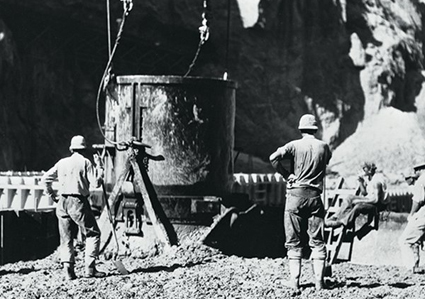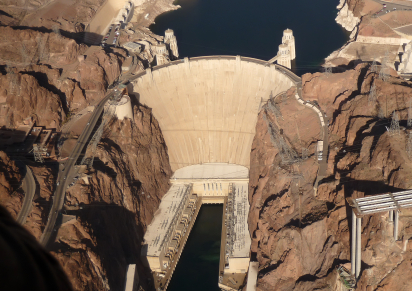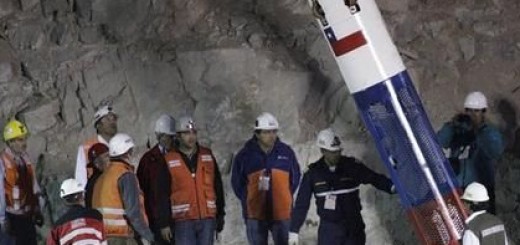The “devastation” of great success.
Click here to listen to the broadcast of You Tell Me on KTBB AM & FM, Friday, May 1, 2010.
The project had a “devastating impact” at the mouth of the river upon which it was built. The completion of the project has been singled out as the beginning of an era of decline in the river’s estuarine ecosystem. The project eliminated natural flooding, which imperiled many species including both plants and animals.
The project decimated the populations of native fish. As a result of the severe impact of the construction project, four species of native fish are today listed as endangered by the U.S. Fish & Wildlife Service.
In addition to the ecological damage, the project resulted in the deaths of 112 workers while permanently altering the natural landscape of a geographic feature known as Black Canyon.
No environmental impact study was conducted prior to commencement of the project. Despite the clear ecological damage that it brought about, there is little outrage regarding the project and no lawsuits are pending.
The project in question is the Boulder Canyon Project. You know it as the Hoover Dam.
The Hoover Dam is an engineering triumph. It was completed in 1936 after five years of construction, two years ahead of schedule. It is listed on the National Register of Historic Places and is one of the Seven Wonders of the Industrial World according to the BBC.
Completion of the Hoover Dam provided a sound water management plan for the previously unpredictable and often dangerous Colorado River. Flooding brought about by snow melt in the Rocky Mountains was brought under control, making irrigated agriculture possible on land that was by seasonal turns dry as bone or flooded.
The water impounded in Lake Mead provides drinking and irrigation water for parts of seven western states, creating cities and commerce that would otherwise not be possible.
And the energy of 22,000 cubic feet per second of water flowing downstream has been harnessed to make electricity that lights southern California, Nevada and Arizona.
You probably knew at some level that the Hoover Dam does all these things. But how aware were you of the environmental damage that the Hoover Dam brought about?
I’ll bet you weren’t aware of it at all.
You would be, however, if the Hoover Dam were proposed today. If the Hoover Dam was put on the drawing board today, it wouldn’t be long before you knew the names of fish species such as the Bonytail Chub and the Colorado Pikeminnow and the Razorback Sucker, all of which are now listed as endangered. You’d know the names of these fish because even though you have lived your entire life right up until just this minute happily unaware of their existence and utterly unaffected by their potential demise, they would be the subjects of expensive and protracted lawsuits filed on their behalf.
Irrespective of how much human good would arise from a 2010 Hoover Dam, politically powerful environmentalists would try to kill the project altogether. Failing that, they would delay its commencement for a decade or longer in the courts and once begun they would interfere at every turn with its construction. You’d never get the Hoover Dam built in 1,777 days if you proposed it in 2010. There’s a good chance you wouldn’t get it built at all.
So what’s the lesson?
I believe there are two. First, the Hoover Dam is just one of countless illustrations of the fact that there is no environmentally benign energy source. In order to harness energy, you have to do something to the earth. There is no other way.
Opponents of oil and coal and natural gas point to wind, water and solar energy as alternatives. Wind turbines, among other things, slaughter birds and bat populations and we count on birds and bats to control insects. Solar energy farms require huge tracts of real estate and a solar panel consumes as much as 11 years worth of the energy it produces in order to manufacture it. Water energy? Well, we have those endangered Bonytail Chubs.
The second lesson is that a growing economy must be able to get things done. That’s what the generations that built the Transcontinental Railroad, the Hoover Dam and the Interstate Highway System did. Today, none of these projects could be completed in a timely manner. All would be stymied in a morass of environmental grandstanding and politically-driven litigation. If proposed today, the proponents would likely not live to see any of them completed and perhaps wouldn’t even live to see them started.
Societies that flourish take risks, carefully count the cost of advancement and then confidently pay it. That’s how America became great.
The oil spill in the Gulf of Mexico is tragic and should not be minimized. But the greater tragedy would be to allow the inevitable accident or the unavoidable tradeoffs attendant to anything worthwhile to kill off the achievement ethic that built the greatest nation in history.










Thank you for this great commentary! We need this viewpoint to continue to be stated.